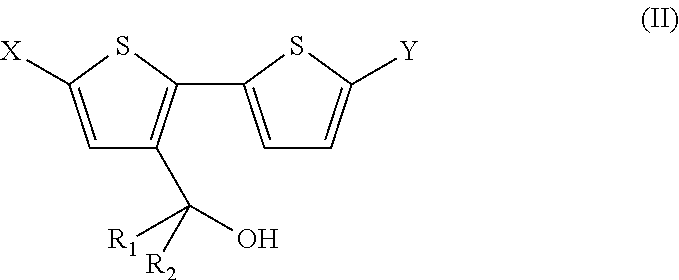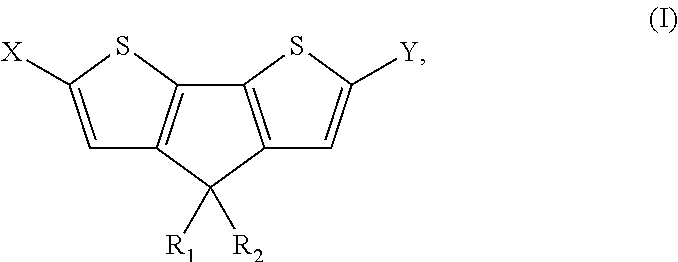4, 4' disubstituted 4h-cyclopentadithiophene and new methods for synthesising the same
a technology of cyclopentadithiophene and disubstituted 4h, which is applied in the field of 4, 4disubstituted 4hcyclopentadithiophene and new methods for synthesising the same, which can solve the problems of mono-substituted 4h-cyclopentadithiophene and the detrimental effect of its use in optoelectronic applications
- Summary
- Abstract
- Description
- Claims
- Application Information
AI Technical Summary
Benefits of technology
Problems solved by technology
Method used
Image
Examples
example 1
3-Bromo-2,2′-bithiophene (IIIa)
[0128]
[0129]This compound was synthesized according to a procedure analogous to the one described in A. Facchetti et al., J. Am. Chem. Soc., 126, 2004, 13480-13501. A Grignard solution of 2-bromothiophene (8.05 mL, 83 mmol) and Mg (2.42 g, 0.10 mol) in dry diethylether (150 mL) was prepared (finally refluxing for 45 minutes under N2). The Grignard solution was added dropwise under N2 over 1 h to a stirred and cooled (about −5° C.) suspension of Pd(dppf)Cl2 (0.41 g, 0.83 mmol) and 2,3-dibromothiophene (V) (9.10 mL, 83 mmol) in dry diethylether (120 mL). After further stirring at 0° C. for 3 h, methanol (10 mL) was added (to quench the reaction) and the mixture was filtered through a 2 cm MgSO4 / silica gel double layer. After further eluting of the double layer with dry diethyl ether (30 mL) the solvent was evaporated under reduced pressure. The residue, an oily liquid, was purified by vacuum distillation (125° C. / 2 mbar). Pure product (IIIa) was obtained...
example 2
3-(2,2′-Bithiophene-3yl)pentan-3-ol) (IIa)
[0130]
[0131]3-Bromo-2,2′-bithiophene (IIIa) (3.00 g, 12 mmol) in dry diethylether (100 mL) was added slowly to a solution of n-butyllithium (1.6 M in hexane, 7.50 mL, 12 mmol) in dry diethylether (100 mL) at −78° C. over 2 h under N2. The mixture was stirred for 15 minutes at the same temperature. Freshly distilled 3-pentanone (1.29 mL, 12 mmol) was added via a syringe to the mixture at −78° C., followed by stirring overnight at room temperature. The reaction was quenched with an aqueous NH4Cl-solution (2.5 M, 50 mL) and water (50 mL) at 0° C. The organic phase was separated and the aqueous phase was extracted with diethylether. The combined organic phases were washed with brine, dried over MgSO4 and evaporated under reduced pressure to give a crude oil. The oily residue was purified by column chromatography (eluent hexane / EtOAc 90:10) to afford the title compound (IIa) as a green oil (1.7 g, 56%). 1H-NMR (CDCl3): δ=7.35 (dd, J=5.2 Hz, J=1.2...
example 3
4,4-Diethyl-4H-cyclopenta[2,1-b:3,4-b′]dithiophene (Ia)
[0132]
[0133]H2SO4 (7.0 mL) was added dropwise to 3-(2,2′-bithiophene-3-yl)pentan-3-ol (IIa) (2.67 g, 11 mmol) under stirring at room temperature. After stirring for 12 h, CH2Cl2 (100 mL) and water (100 mL) were added. The organic layer was separated and the aqueous layer was extracted with CH2Cl2. The combined organic extracts were successively washed with saturated NaHCO3 and brine. After drying over MgSO4, the solvent was removed in vacuo. The crude oil was purified with column chromatography (eluent hexane) to afford pure dark yellow oil (Ia) (1.2 g, 47%). 1H-NMR (CDCl3): δ=7.21 (d, J=4.8 Hz, 2H), 7.00 (d, J=4.8 Hz, 2H), 1.98 (q, J=6.8 Hz), 4H), 0.70 (t, J=7.0 Hz, 6H). 13C-NMR (CDCl3): δ=157.89, 137.36, 125.09, 122.16, 54.76, 30.71, 9.74.
PUM
| Property | Measurement | Unit |
|---|---|---|
| pKa | aaaaa | aaaaa |
| temperature | aaaaa | aaaaa |
| temperature | aaaaa | aaaaa |
Abstract
Description
Claims
Application Information
 Login to View More
Login to View More - R&D
- Intellectual Property
- Life Sciences
- Materials
- Tech Scout
- Unparalleled Data Quality
- Higher Quality Content
- 60% Fewer Hallucinations
Browse by: Latest US Patents, China's latest patents, Technical Efficacy Thesaurus, Application Domain, Technology Topic, Popular Technical Reports.
© 2025 PatSnap. All rights reserved.Legal|Privacy policy|Modern Slavery Act Transparency Statement|Sitemap|About US| Contact US: help@patsnap.com



